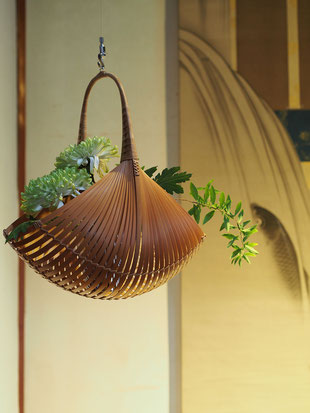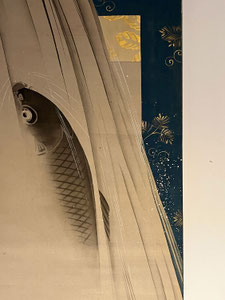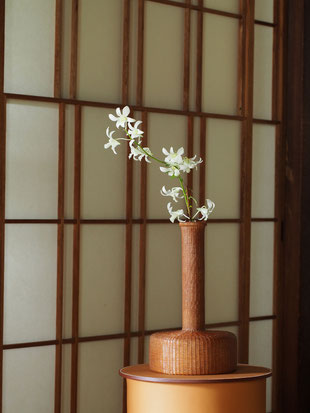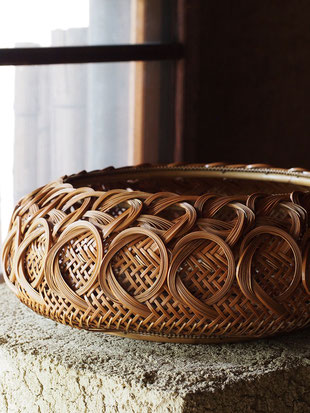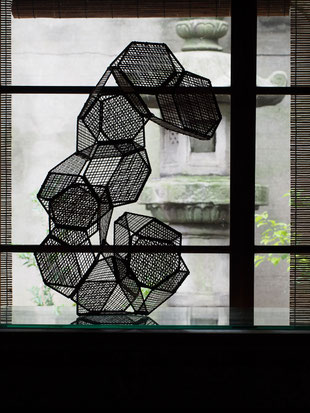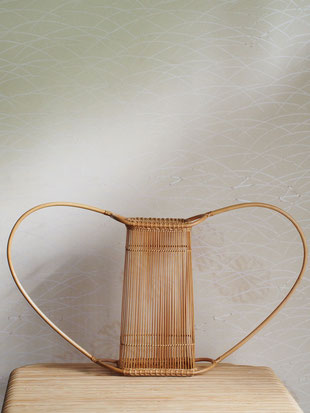8月、夏の京都店に展示されている竹の作品をいくつかご紹介します
This is a work from Shounsai's later years, a bold piece that makes use of the simple beauty of bamboo, and exudes a profound sense of his talent. The fan, considered auspicious because it "widens at the end," is a traditionally beloved motif in Japan. The gently swaying flower basket and the slowly rotating flowers reveal a variety of expressions. In 1967, Shounsai was recognized as the first holder of an Important Intangible Cultural Property in the field of Bamboo crafts , and made a significant contribution to the development of bamboo craft.
At the Yumekoubou Bamboo Collection Exhibition held in June this year, an impressive display featuring crimson flowers caught the eye of visitors.
「砧」花籃
二代田辺竹雲斎(1910-2000)
16.5cm x 28cm
’Kinuta’ Flower basket
Tanabe Chikuunsai Ⅱ(1910-2000)
「砧 - きぬた」は、古くから布を打つために使われてきた民具で、和歌や浮世絵、茶道具など伝統的な作品の題材として使われています。細い竹ひごを密に編むことでシンプルな形を強調させるこの「抜き編み」は、二代竹雲斎が得意とした作風の一つです。
The "Kinuta" is a folk tool that has been used since ancient times to beating for soften cloth, and is used as a subject for traditional works such as waka poetry, ukiyo-e, and tea ceremony utensils. This "nukiami" technique, which emphasizes simple shapes by tightly weaving thin bamboo strips, was one of Chikuunsai II's specialties.
結銭苔文石貨花籃
末村笙文(1917-2000)
43.5cm x 15.8cm
Flower basket
Suemura Shobun(1917-2000)
極細にカットされた竹材を幾重にも重ねた束が、リズミカルに連なることで、ダイナミックな景色を作り出しています。全体の平らで円い形は、古代の石の貨幣をイメージしており、ゼニゴケの葉の文様と合わさることで、笙文の想像力豊かな構図の面白さが表現されています。現代のアート作品としても通用する花籃です。
The rhythmic arrangement of multiple layers of extremely thinly cut bamboo creates a dynamic landscape. The overall flat, circular shape is reminiscent of ancient stone coins, and combined with the liverwort leaf pattern, it expresses the imaginative and fascinating composition of Shobun. This flower basket could also be used as a contemporary piece of art.
伝統的な竹工芸とは一線を画す彼の作品は、幾何学的な発想からヒントを得ています。この不思議な形は、六角形が連続する規則性と上下左右という空間の制限に捉われない全体の自由さとが共存しています。それがシンプルで心地よい視覚効果を生み出しています。
His work, which stands out from traditional bamboo crafts, is inspired by geometric ideas. This strange shape combines the regularity of a series of hexagons with an overall freedom that is not bound by spatial limitations such as up, down, left, and right. This creates a simple and pleasant visual effect.
蝶が羽を広げたような全体の美しい姿。細く整えられた竹ひごが真っ直ぐ縦方向に並ぶ「真垣編み」はそのシンプルさ故の難しさがあります。洗練された上品なこの花籃は、歴代の竹雲斎から受け継がれた美の哲学を象徴しています。
The overall appearance is beautiful, like a butterfly spreading its wings. Magaki-ami, in which thin, trimmed bamboo strips are lined up vertically in a straight line, is difficult to make due to its simplicity. This refined and elegant flower basket symbolizes the philosophy of beauty passed down through successive generations of Chikuunsai.
This is a collaborative series with geometric designer Sawako Kaijima. Using digital technology, Chikuunsai IV has transformed quantified designs into realistic artworks using bamboo. These beautiful, regular trajectories could not be produced by human intelligence alone. They are only possible thanks to the straight and flexible properties of bamboo, beautiful geometric data, and solid traditional techniques. The result is the sensation of gazing at a magnificent landscape, like the movement of celestial bodies in space.
鱗編みは、竹雲斎を代表する編み技法の一つで、三角に並ぶ編み目が魚の鱗に似ていることから名付けられました。シンプルな筒形ですが、透かして見た時の美しさは格別です。1ミリに満たない極細の竹ひごの加工には高度な技術を要します。この軽やかな花籃は、自然光との相性が良く空気と光を含んだ姿は、竹林の清涼な景色と重なります。
Uroko-ami is one of Chikuunsai's signature weaving techniques, and is named after the triangular weave that resembles fish scales. It has a simple cylindrical shape, but its beauty is exceptional when viewed through the glass. Processing extremely thin bamboo strips that are less than 1 mm requires advanced techniques. This light flower basket is well suited to natural light, and its airy and light-filled appearance is reminiscent of the refreshing scenery of a bamboo forest.

